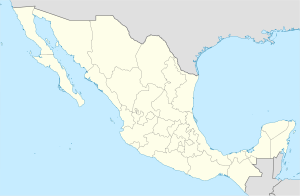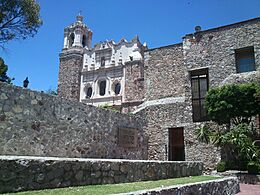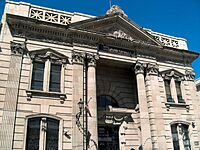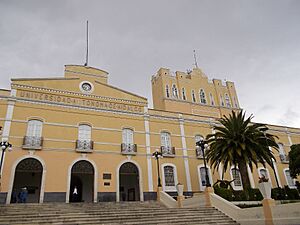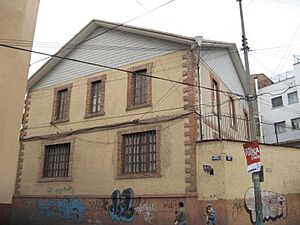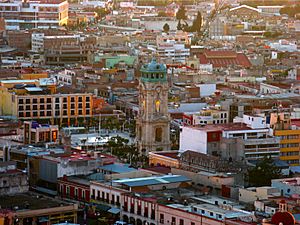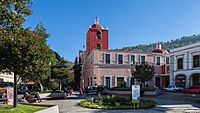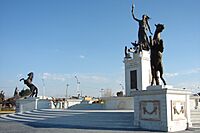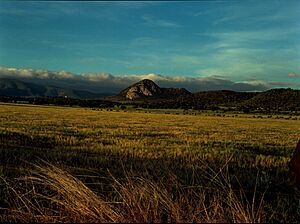Pachuca facts for kids
Quick facts for kids
Pachuca
Nju̱nthe (Mezquital Otomi)
|
|||
|---|---|---|---|
|
City and Municipality
|
|||
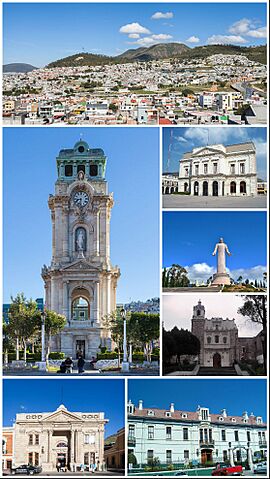
Left:Panorama view of Pachuca, including Lobo Hills, Los Chavez, from Cubitos Ecological Park, Pachuca Monument Clock Tower, Pachuca Bancomer heritage building, Right:Medina Hidalgo Bartolomé Teather (Teatro Hidalgo Bartolomé de Medina), Christ King of achuca (Cristo Ray de Pachuca), Pachuca Saint Francis of Assisi Monastery, Pachuca Municipal Palace (Palacio Municipal de Pachuca)
|
|||
|
|||
| Nickname(s):
La Bella Airosa (The Windy Beauty)
|
|||
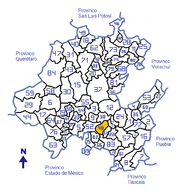
Location of Pachuca Municipality within Hidalgo
|
|||
| Country | |||
| State | |||
| Municipality | |||
| Government | |||
| • Type | Ayuntamiento | ||
| Elevation | 2,432 m (7,979 ft) | ||
| Population
(2015) Municipality
|
|||
| • Total | 277,375 | ||
| • Seat | 256,584 | ||
| Time zone | UTC−6 (CST) | ||
| • Summer (DST) | UTC−5 (CDT) | ||
| Website | www.pachuca.gob.mx | ||
Pachuca (pronounced pa-CHOO-ka), officially known as Pachuca de Soto, is the capital city of Hidalgo, a state in east-central Mexico. It's the biggest city in Hidalgo and is located in the southern part of the state. Pachuca is also the name of the area (municipality) where the city is located. You can find Pachuca about 90 kilometers (56 miles) north of Mexico City.
The name Pachuca has a few possible meanings. It might come from words meaning 'strait' or 'opening'. Other ideas suggest it means 'place of government' or 'place of silver and gold'. Some even think it means 'place of factories' or 'place of tears'.
The city's full name, Pachuca de Soto, honors Manuel Fernando Soto. He was a congressman who helped create the state of Hidalgo. Pachuca is also nicknamed La Bella Airosa which means "the airy, beautiful" because of the strong winds that blow through the canyons nearby. In the native Otomi language, Pachuca is called Nju̱nthe. People have lived in this area for a very long time. While green obsidian was mined here early on, the famous silver mining began in the mid-1500s, during Spanish rule.
Pachuca was a major mining city until the mid-1900s. Its success depended on how well the mining industry was doing. When mining slowed down in the mid-20th century, the city changed its focus to other industries. The Universidad Autónoma de Hidalgo was also updated to help with this change. Today, mining is only a small part of Pachuca's economy. A special part of Pachuca's culture comes from the Cornish miners. They moved here from Great Britain in the 1800s, and many of their families still live in Pachuca and nearby Real del Monte. These Cornish people also helped start two traditions that are very important to the city: football (soccer) and a tasty dish called "pastes."
Contents
History of Pachuca
People lived in this area as far back as 12,000 BCE. Evidence of early human life, like tools made from green obsidian and mammoth remains, has been found in places like Cerro de las Navajas. An ancient center for making obsidian tools was also found near the city in San Bartolo. Around 2,000 BCE, nomadic groups started to settle down and form farming villages. This area was then known as Itzcuincuitlapilco. Later, between 200 CE and 850 CE, the area showed signs of influence from the Teotihuacan civilization.
After the Teotihuacan period, the Chichimecas took control, calling the area around Pachuca Njunthé. They pushed the native Otomis into the Mezquital Valley. Eventually, the Aztec Triple Alliance took over between 1427 and 1430. It's believed that silver mining began in Pachuca and nearby Real del Monte after this conquest. The Aztec government center was located where Plaza Juárez is today.
Spanish Arrival and Mining Boom
The Spanish arrived in 1528. Francisco Téllez, an artilleryman who came with Hernán Cortés, is often given credit for the Spanish conquest of Pachuca. He and Gonzalo Rodriguez were the first Spaniards here. However, major mining resources weren't found until 1552. The most likely story says that Alonso Rodríguez de Salgado found the first mineral deposits on his ranch. This discovery quickly changed the area's economy from farming to mining.
By 1560, Pachuca's population had grown quickly to 2,200 people, mostly working in mining. The first main plaza was built next to the Asunción Parish. The Cajas Reales (Royal Safe) was also built to store the king's share of the mined silver.
In 1554, Bartolomé de Medina found even larger mineral deposits. He also developed new ways to get minerals from the ore using the "patio process." This made Pachuca grow even more. Mining operations spread to nearby areas. The town continued to grow, and in 1813, Pachuca was officially declared a city.
Mining Challenges and Revival
Mining slowed down by the 1700s because of flooding in the mines. But in 1741, Pedro Romero de Terreros, the first Count of Regla, and his partner Jose Alejandro Bustamante, invested in new drainage systems. They also found new silver deposits, mostly in nearby Real del Monte. By 1746, Pachuca had many Spanish, mixed-race, and indigenous families.
During the Mexican War of Independence, the city was taken in 1812. This caused many mine owners loyal to Spain to leave. The war left Pachuca in a difficult situation. The third Count of Regla brought the first Cornish miners and new technology around 1824. The Cornish took over the abandoned mines, bringing modern equipment from Cornwall. Cornish companies controlled mining here until 1848. The Mexican–American War forced them to sell their mines to a Mexican company. Mining started again in 1850, especially in the Rosario mine.
Modern Pachuca: From Mining to Industry
Mining was interrupted again by the Mexican Revolution in the early 1900s. Forces loyal to Francisco I. Madero took the city in 1911. Later, a general under Pancho Villa entered the city in 1915. Both invasions happened because of the economic importance of the mines. During this time, American investors came to Pachuca and updated the mining technology. From 1906 to 1947, the United States Smelting, Refining and Mining Company was the main producer. However, by 1947, mining became too expensive due to political problems, worker disputes, and low silver prices. The company sold its mines to the Mexican government in 1965.
The decline in mining in the mid-1900s had a big impact on Pachuca. Many old buildings were in danger of falling apart. Under government ownership, mining almost stopped. During this time, Pachuca's economy started to change from mining to other industries. The old Instituto Científico Literario Autónomo de Hidalgo became the Universidad Autónoma del Estado in 1961. This university helped the city grow by training skilled workers in law, engineering, business, and medicine. In the late 1950s and 1960s, new housing was built for workers in new factories.
Pachuca's population grew again in the 1970s and 1990s. This was because of new industries and a growing student population at the state university and other schools. Many government offices also moved to Pachuca, with new buildings like the State Government Palace. Much of the city's growth came from new housing projects. Important infrastructure projects, like a new Municipal Market and the main bus station, were also built.
Pachuca's Climate and Geography
Pachuca is in a small valley, surrounded by large hills covered with colorful houses. The city center still has many old colonial buildings and narrow, winding streets. Outside the center, you'll find the more modern Pachuca, with factories, supermarkets, and a large football stadium called El Huracán (The Hurricane). The local football team has won many titles there.
What is Pachuca's Climate Like?
Pachuca has a semi-arid climate. This means it's cool with a good amount of rain and sometimes hail during the summer. Winters are dry. January is the coldest month, with average highs around 20°C (68°F) and lows around 3°C (37°F). Winter nights can be very cold, sometimes dropping below 0°C (32°F). May is the warmest month, with highs around 24°C (75°F) and lows around 9°C (48°F). Because Pachuca is high up, nights stay cool all year. The city gets about 412 millimeters (16 inches) of rain each year, mostly from May to September. The highest temperature ever recorded was 34.5°C (94°F), and the lowest was -9°C (16°F).
Exploring Pachuca City Attractions
Pachuca is known for its mining history, so many attractions are related to this industry. Many of these are found near Hidalgo Street, one of the oldest streets in Pachuca. It runs along the main plaza (Plaza de la Constitución) to Hidalgo Park. The oldest markets and houses are also on this street, and many are well-preserved.
Famous Landmarks in Pachuca
- Reloj Monumental
The Monumental Clock of Pachuca is the most famous symbol of the city. It was a gift from Cornishman Francis Rule. It was built to celebrate 100 years of Mexican independence and opened on September 15, 1910. The clock's inner parts were made by the same company that built Big Ben in London. The outside monument is Mexican-made. It's a 40-meter (131-foot) tall tower made of white stone in a Neoclassic style. In the middle, there are four marble sculptures of women representing Reform, Liberty, Independence, and Constitution.
- Church and Ex-Monastery of San Francisco
The Church and ex-monastery of San Francisco started being built in 1596. The church was finished around 1660. Its front is in the colonial Spanish Baroque style. Inside, you can still see parts from the 1500s. The church has old oil paintings by famous artists from the 1700s. The old monastery building was restored and now houses the Centro Cultural Hidalgo. Behind the church is the Chapel of Nuestra Señora de la Luz, built in the 1600s and 1700s. It has the only Churrigueresque altar in the city, which also holds the remains of the Count of Regla.
Today, the Museum of Photography and the Regional Museum are located in this complex. The photography museum shows old cameras and photos by famous photographers. Next to the monastery is the Bartolomé de Medina Park.
- Asunción Church
The Asunción Church is the oldest church in Pachuca, built in 1553. It has been rebuilt several times, with a major renovation in 1719. The entrance has two levels, with a round arch and columns. The bell tower also has two levels with round arches.
- Bancomer Building
The Bancomer Building is in front of the main plaza. It was built in 1902 in the Neoclassical style. It was first a bank, then a hotel, and now it's a bank again. It has a beautiful brown stone front with sculpted details and a lion figure on top.
- Cajas Reales
The Cajas Reales was where miners paid 20% of their silver to the Spanish Crown as taxes. It was also the only place that sold mercury, which was needed to get silver from the ore. It was built in the 1600s. It's a two-story building with a central courtyard. It has housed the offices of a mining company since 1850.
- Methodist Church
The Methodist Church was built in the early 1900s. It stands out because of its Romanesque Revival style, which is rare in the area. It's an important building from the time of the Cornish miners. It is still a Protestant church today.
- Historic Archive and Museum of Mining
The Archivo Historico y Museo de Minería—Historic Archive and Museum of Mining is on Mina Street. It's in a large house from the 1800s. This museum has documents that show the history of mining in Pachuca from 1556 to 1967. It also shows how much silver and gold was taken from Hidalgo state. The museum has three exhibit rooms, a courtyard, and a garden with old mining machines. It also has a large collection of documents, a library, and photos.
- Museum of Mineralogy
The Museo de Mineralogía—Museum of Mineralogy belongs to the Universidad Autónoma del Estado de Hidalgo. It's in the old Hospital de San Juan de Dios. This museum shows a large collection of minerals found in the region.
- Municipal Palace—Rule House
The Municipal Palace or Conde Rule House is a two-story building from the late 1800s. It used to belong to a rich Cornish miner named Francis Rule. Later, it became the city's Municipal Palace.
- Macromural
The macromural of Pachuca is in the Palmitas neighborhood. It's an entire hillside painted with colorful murals, making the whole area look like a giant artwork.
- Other Fun Places to Visit
- The Mercado de Barreteros is in the Central Plaza. It's a beautiful building with cafes on the lower level and arts and crafts shops upstairs.
- The Monument of Christ the King is on Santa Apolonia Mountain. It's one of the biggest statues of Christ in Mexico.
- The Museo El Rehilete is an interactive museum for kids. It has exhibits about archeology, plants, science, and art.
- The Sede del Salón de la Fama del Fútbol—Hall of Fame of Football is shaped like a football. It's in Parque David Ben Gurion.
- The Universidad de Fútbol—Football University is a special training facility for football players. It's the only one of its kind in the Americas.
Education in Pachuca
The Universidad Autónoma del Estado de Hidalgo is the oldest school in Hidalgo. It started in 1869 as the Literary Institute and School of Arts and Letters. In 1875, it moved to the former Hospital of San Juan de Dios, which is now its main building. The university's motto is "Amor, orden y progreso" ("love, order and progress"). The university was reorganized and grew in 1961.
A newer school, the Universidad Politécnica de Pachuca (Polytechnic University of Pachuca), opened in 2003. It's mainly an engineering school. In 2004, it moved to the old Santa Barbara Hacienda. It offers programs in Mechatronics, Information technology, Biotechnology, and other fields.
Pachuca's English and Cornish Influence
Starting in 1824, miners from Cornwall, England, and English investors came to Pachuca and Real del Monte. They invested in and worked in the mines. This created a unique community in Mexico. In the early 1800s, miners in Cornwall faced tough times. Ships carrying miners and their equipment sailed to Mexico. The long journey inland was very difficult, and many died from diseases. Those who survived settled in Pachuca and Real del Monte.
The immigrants brought new technology, like powerful steam pumps designed by Cornish engineer Richard Trevithick. These pumps helped drain water from the mines, making them produce huge amounts of silver. Most of the miners came from Cornish mining areas like Camborne and Redruth. The Cornish and English workers helped the silver industry here become strong again.
Architecture with English Style
Today, the Pachuca – Real del Monte area still shows a lot of Cornish influence. Many houses in the hills around Pachuca have British features, like thick walls, square windows, and pitched roofs. Some of Pachuca's famous buildings also show English/Cornish influences. The Monumental Clock of Pachuca plays the same chimes as Big Ben and was paid for by Francis Rule. The city's main Methodist church was built by Cornish miners. The old English mining company's main office and the home of Francis Rule still show his initials. The "Historic Archive and Museum of Mining" has detailed records of Cornish workers from 1824 to 1849.
Cultural Influences: Football and Pastes
The Cornish immigrants married into Mexican families, and even today, you can find Cornish last names in this area. The Cornish-Mexican Cultural Society works to connect Mexico and the United Kingdom. They even call Pachuca and Real del Monte "Mexico's Little Cornwall."
The Cornish and English miners brought many things to Mexico, like tennis, golf, rugby, cricket, and chess. But two things had the biggest impact on Pachuca's identity: football (soccer) and pastes.
Football: The Cradle of Mexican Soccer
In 1900, Cornish miners started the Pachuca Athletic Club, which focused on football. Their first game was played that same year. The first Pachuca team had many English players. The Pachuca club helped other teams form in Mexico City and Orizaba. The first championship of the new Liga Mexicana de Fútbol Asociación was played in 1902. Other clubs were also formed by miners. The first Mexican player joined the Pachuca club in 1908, and by 1915, most of the team was Mexican. Pachuca won the Copa Tower in 1908 and 1912. The team stopped playing in the 1920s but started again in 1951. Pachuca proudly calls itself the "Cradle of Mexican Football."
Pastes: A Delicious Tradition
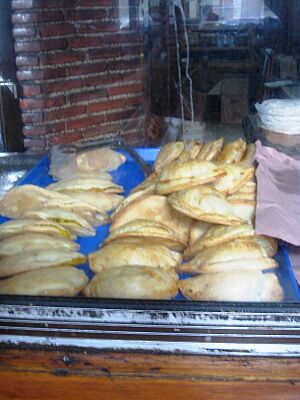
The Mexican Spanish word "paste" (pronounced PAH-steh) comes from the Cornish word "pasties." A paste is a semi-circular pastry with sweet or savory fillings. Cornish miners brought the recipe with them because pastes were a good way to carry their lunch to the mines. Both pasties and pastes have a thick braided edge. This edge was originally for miners to hold the pastry without getting the food dirty, since they couldn't wash their hands underground. The shape and pastry are still the same, but today, the fillings are Mexican. You can find pastes with mole verde, beans, chicken "tinga," pineapple, rice pudding, and even a seasonal lamb paste with poblano chili peppers. Pastes are a local specialty strongly connected to Pachuca and Real del Monte.
Pachuca's Festivals
The Feria de Pachuca is also known as the Feria Tradicional/Internacional de San Francisco or the Feria de Hidalgo. It's the most important yearly event in Hidalgo state, happening every October in southern Pachuca. The festival started as a religious event organized by monks in the 1500s. Today, it includes many events like bullfights, cockfights, charreadas (Mexican rodeos), horse shows, craft displays, folk dances, and livestock exhibitions. It also features regional food and concerts by famous Mexican musicians.
Other important events in the city include the Ramón Noble Guitar Festival and the Feria Hidaltur. The Guitar Festival features concerts by guitarists from different countries and offers classes and workshops. The Feria Hidaltur is held in March and April to promote Hidalgo state's arts and crafts. It also has horse events and hot-air balloons.
-
The Monument La Victoria del Viento in Bicentennial Plaza
Pachuca's Economy
Even though mining has declined, it's still an important part of Pachuca's economy. Pachuca still produces over 60% of Hidalgo state's gold and over 50% of its silver. The Mexican Geological Survey has its main office in the city.
The manufacturing industry started in the 1950s and has been growing steadily. Major companies in Pachuca make things like car parts and machinery. The city also has over 800 smaller manufacturing businesses.
Pachuca's economy also has a large commercial sector with many stores and thirteen public markets. It's a central place for selling food to most of the state.
Despite all the changes, Pachuca's city center still feels like a traditional Mexican town. Because of this, the city promotes itself as a tourist destination.
Pachuca Municipality
The Pachuca Municipality is becoming more and more like the city itself. The city's growth is covering over 60% of the open land in the municipality. The municipality includes fifteen other communities, but most of them have fewer than 1,500 people. Only about three percent of the municipality's population lives outside the city limits.
Mines of Pachuca
All of Pachuca’s mines worked with silver ore. The last mine to close was El Álamo in 1993.
- Rosario Mine
- El Álamo Mine
- San Juan Mine
- Corteza Mine
Sister Cities
Pachuca has special connections with these cities:
 Ponferrada, Spain
Ponferrada, Spain Little Rock, Arkansas, United States
Little Rock, Arkansas, United States Camborne, Cornwall, UK
Camborne, Cornwall, UK Eagle Pass, Texas, United States
Eagle Pass, Texas, United States
Notable People from Pachuca
- Berta Zerón (1924–2000), a Mexican aviator (pilot)
- Mara Reyes (born 1977), a Mexican racing driver
- María Fassi (born 1999), a Mexican professional golfer
See also
 In Spanish: Pachuca de Soto para niños
In Spanish: Pachuca de Soto para niños




